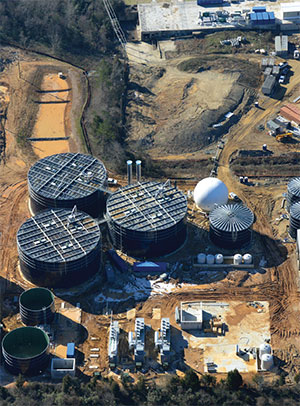BioCycle February 2016
Edmonton, Alberta: City Proceeds With High Solids AD Facility
The City of Edmonton, in Alberta, Canada, built its composting facility in 2000 to process biosolids. The plant now composts about 176,300 tons/year of biosolids and other organics, and is expected to reach capacity in mid-2016. To add capacity, Edmonton is proceeding with construction of a 53,000 tons/year anaerobic digester to help the city reach its goal of diverting 90 percent of residential garbage from landfilling between 2018-2020. The high solids Viessmann Group/BIOFerm™ dry fermentation technology was selected. The construction budget is $30.8 million.
This facility is a partnership between the City of Edmonton and the University of Alberta. It will allow both partners to increase waste diversion rates and continue reducing greenhouse emissions from their activities. The University will contribute about $800,000 to the facility cost and send about 1,650 tons/year of food scraps to the AD plant. The Climate Change and Emissions Management Corporation (CCEMC), which has a mandate to provide funding for initiatives that reduce greenhouse gas (GHG) emissions or improve Alberta’s ability to adapt to climate change, has provided $10 million in funding. The CCEMC estimates the Edmonton project will reduce GHG emissions by 198,570 metric tons by 2020. The AD facility is scheduled to be in operation by the end of 2017.
Charlotte, North Carolina: AD Facility Making Progress
 Blue Sphere Corporation, through its subsidiary Orbit Energy Charlotte LLC, is nearing completion of its planned 115,000 tons/year anaerobic digester facility to process food wastes and similar substrates. Electricity will be produced from the biogas and sold into the existing utility grid through a 15-year power purchase agreement with Duke Energy. At full capacity, the plant will produce about 5.2 megawatts (MW) of electrical power and thermal energy. Start-up is planned for the spring of 2016.
Blue Sphere Corporation, through its subsidiary Orbit Energy Charlotte LLC, is nearing completion of its planned 115,000 tons/year anaerobic digester facility to process food wastes and similar substrates. Electricity will be produced from the biogas and sold into the existing utility grid through a 15-year power purchase agreement with Duke Energy. At full capacity, the plant will produce about 5.2 megawatts (MW) of electrical power and thermal energy. Start-up is planned for the spring of 2016.
Food waste will be delivered by closed transport trucks and open top trailers; trucks will unload in a designated area in a fully enclosed reception building that will be operated under negative pressure (building air will be routed to a biofilter). An Austep Tornado wet separation and extrusion system is being installed to remove packaging and inerts from organic feedstocks. Output from the unit will be routed to a tank and mixed with liquid food wastes and captured process water. The mixed contents will be loaded into the first stage of a two-stage digester system sourced from Austep, which will have a solids residence time of about 35 days. The second stage will serve primarily as digestate storage. Digestate will be dewatered with a screw press followed by a centrifuge and the solids sent to a drying system; liquid effluents will be routed to an on-site activated-sludge wastewater pretreatment system or back to the preload tank. Partially dried digestate will be sent off-site for composting at a regional facility. Ammonia-rich exhaust air from the drying system will be scrubbed with sulfuric acid to make ammonium sulfate fertilizer, according to Blue Sphere’s solid waste permit issued by the North Carolina Department of Environment and Natural Resources.
Biogas will be washed with sodium hydroxide to remove hydrogen sulfide and then sent to a refrigerated chiller to remove moisture prior to combustion in a combined heat and power generator. The plant is located on a 13-acre site in an industrial area in Charlotte. Estimated construction cost is $27 million.











